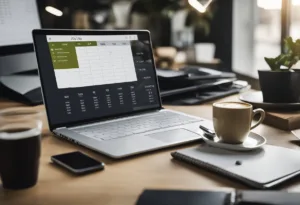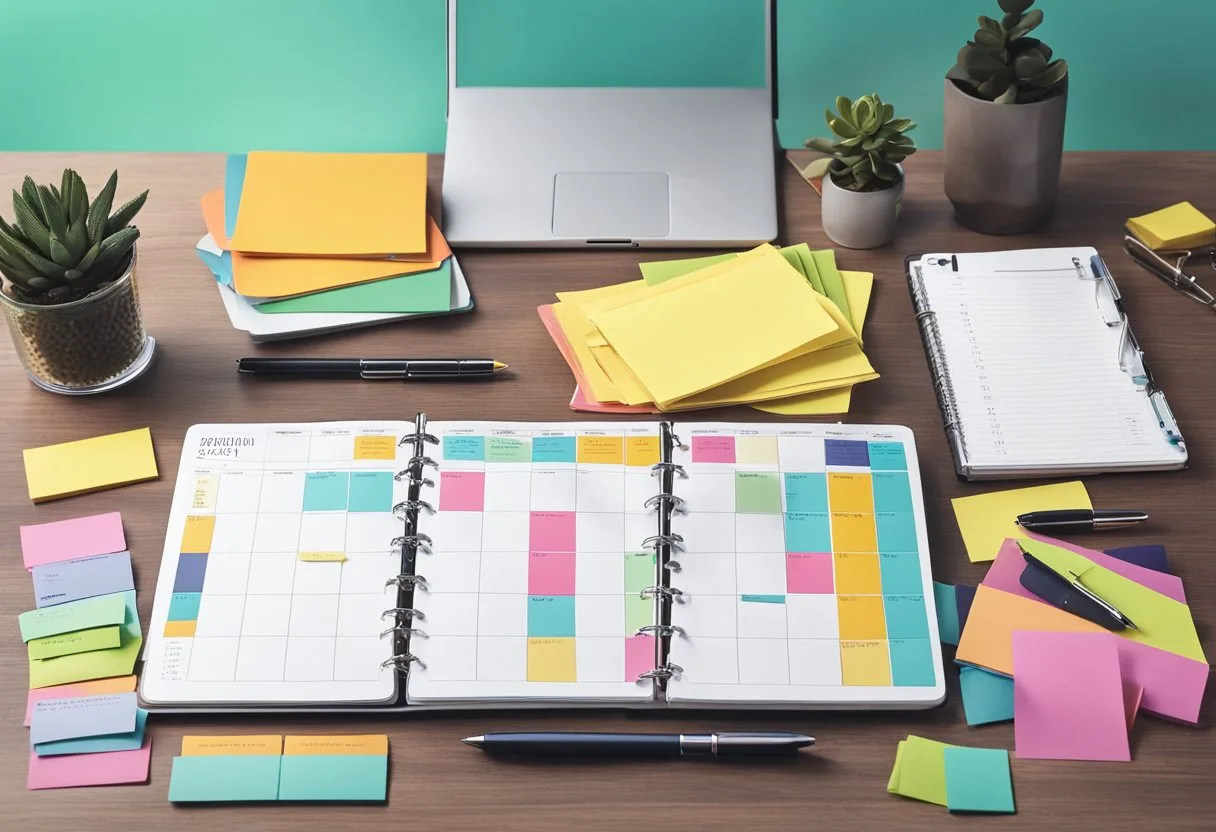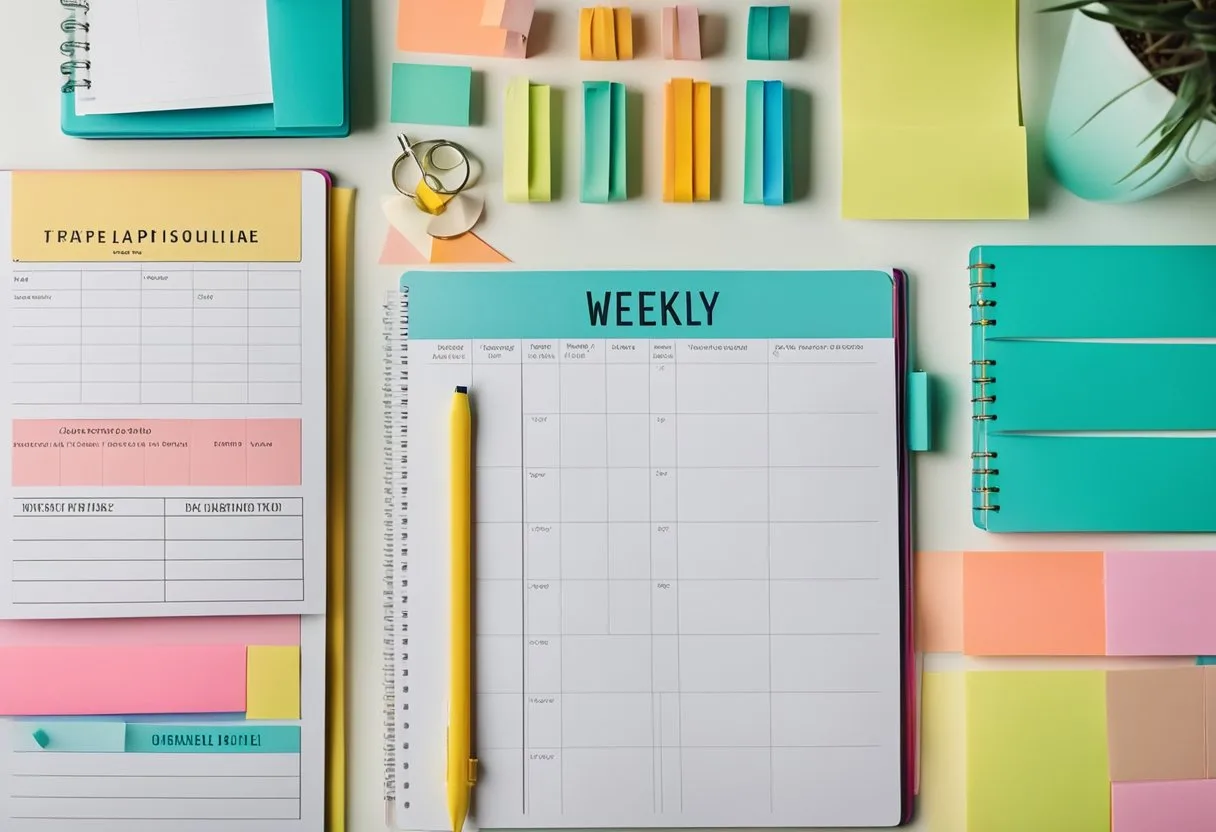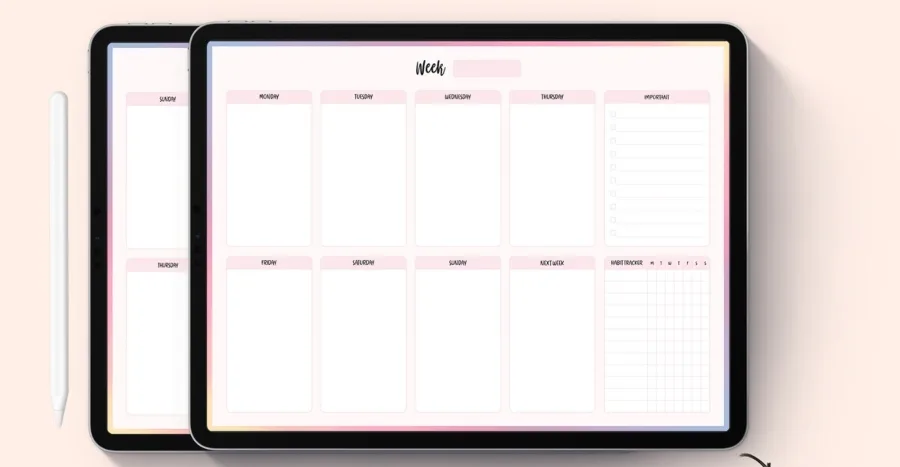Using a planner can be a great way to stay productive and organized at work. However, many people struggle to use their planners effectively. In this article, we will provide some tips and tricks for how to use a planner for work. In this blog post, I will walk you through how to use a planner for work and provide you with planner ideas that will help you maximize your productivity.
First and foremost, it is important to choose the right planner for your needs. Consider factors such as size, layout, and design. Some people prefer a daily planner with detailed scheduling, while others may prefer a weekly or monthly planner with more space for notes and to-do lists. It is also important to choose a planner that you find visually appealing and enjoyable to use.
Once you have chosen a planner, it is important to use it consistently. Make it a habit to update your planner at the same time each day or week. Use your planner to set goals, prioritize tasks, and keep track of deadlines. Don’t be afraid to experiment with different organizational methods until you find what works best for you. By following these tips, you can use a planner to stay productive and organized at work.
Choosing the Right Planner
When it comes to choosing the right planner for work, there are a few things to consider. One of the most important decisions is whether to go with a paper planner or a digital planner. Each has its own advantages and disadvantages, so it’s important to think carefully about which one will work best for you.
Paper vs Digital Planners
Paper planners are a great option for those who prefer the tactile experience of writing things down. They can be customized with stickers, colored pens, and other decorative elements, making them a fun and creative way to stay organized. They also don’t require an internet connection or battery life, so they’re always available when you need them.
On the other hand, digital planners offer a lot of convenience and flexibility. They can be accessed from anywhere with an internet connection, and they often come with helpful features like reminders and automatic syncing. They also allow for easy sharing and collaboration with others.
The choice between paper and digital planners comes down to personal preference. Some people find that they work best with a combination of both, using a paper planner for daily to-do lists and a digital planner for long-term planning and scheduling.
Types of Planners
Once you’ve decided on paper or digital, the next step is to choose the type of planner that will work best for you. There are a variety of options available, including:
- Daily planners: These planners offer a page for each day of the year, allowing you to plan out your schedule in detail.
- Weekly planners: These planners offer a page for each week, making them a good option for those who don’t need to plan out their days in as much detail.
- Monthly planners: These planners offer a page for each month, making them a good option for those who need to plan out their schedule on a broader scale.
- Yearly planners: These planners offer a page for each year, making them a good option for those who need to plan out their long-term goals and projects.
When choosing a planner for work, it’s important to consider your specific needs and preferences. For example, if you have a lot of meetings and appointments, a daily or weekly planner may be the best choice. If you’re more focused on long-term projects and deadlines, a monthly or yearly planner may be a better fit.
Choosing the right planner for work is an important decision that requires careful consideration. Whether you go with a paper or digital planner, and whether you choose a daily, weekly, monthly, or yearly format, the most important thing is to find a planner that works for you and helps you stay organized and productive.
How to use a planner for work
- Choose the Right Planner: Select a planner that suits your work style, whether it’s a daily, weekly, or monthly layout, and ensure it has enough space for your needs.
- Familiarize with the Layout: Get to know the structure of your planner. Identify where you’ll write down appointments, tasks, notes, and deadlines.
- Start with Key Dates: Input all known important dates such as meetings, deadlines, and events into your planner to create an overview of significant upcoming commitments.
- Plan Your Week in Advance: At the start of each week, block out time for existing meetings and deadlines. Then, schedule time for task completion and project work.
- Daily Planning: Each morning, review your planner and update it with any new tasks or meetings. Prioritize your tasks by urgency and importance.
- Track Project Progress: Use your planner to break down projects into smaller tasks and milestones, assigning deadlines to each to monitor progress over time.
- Incorporate Time Blocking: Assign specific blocks of time to focus on different categories of work, such as emails, project work, and meetings, to manage your day effectively.
- Review and Adjust: At the end of the day, review what was accomplished and shift any incomplete tasks to the next day or week, adjusting your plan as necessary.
- Keep It Updated: As changes occur, immediately update your planner to reflect new appointments or shifted deadlines to maintain an accurate schedule.
- Reflect Weekly: At the end of the week, review your accomplishments and any outstanding tasks. Use this reflection to plan for a more productive week ahead.
10 planner ideas for work
- Task Prioritization: Use symbols or color-coding to prioritize tasks by urgency (e.g., a red dot for high-priority tasks).
- Meeting Notes: Dedicate a section for taking brief notes during meetings, which can be referred back to when needed.
- Deadline Tracker: Keep a running list of deadlines to ensure you’re always prepared for upcoming due dates.
- Project Milestones: Outline key milestones for each project and check them off as they are completed.
- Contact List: Maintain a list of important contacts, including clients and team members, for quick reference.
- Goal Setting: Write down professional goals and the actionable steps needed to achieve them.
- Idea Log: Keep a space for jotting down spontaneous ideas or inspiration that can be explored later.
- Professional Development: Track progress toward professional development, such as courses taken or certifications achieved.
- Workflow Mapping: Sketch out workflows for complex tasks or projects to visualize the steps involved.
- End-of-Day Review: Take a few minutes at the end of each day to assess what worked well and what could be improved for future planning.
Setting Up Your Planner
When it comes to using a planner for work, the first step is to set it up properly. This involves identifying important dates and goals, as well as creating a task management system.
Important Dates and Goals
Before setting up your planner, it is important to identify any important dates or deadlines that you need to keep track of. This could include meetings, project due dates, or other events that are critical to your work. Once you have identified these dates, you should add them to your planner’s calendar.
In addition to important dates, you should also set goals for yourself. These could be short-term or long-term goals, but they should be specific and measurable. For example, if you want to increase sales by 20% in the next quarter, you should set that as a goal in your planner.
Creating a Task Management System
Once you have identified important dates and goals, the next step is to create a task management system. This involves breaking down your goals into smaller tasks and creating a checklist of things that need to be done.
One way to do this is to create a table in your planner that lists each task, along with its due date and any other relevant information. You can then check off each task as it is completed, which will help you stay on track and ensure that nothing falls through the cracks.
Another option is to use a bullet journal-style system, where you create a page for each day and list out the tasks that need to be done. This can be a more flexible approach, as you can easily add or remove tasks as needed.
The key to setting up your planner for work is to find a system that works for you. Whether you prefer a digital planner or a paper planner, the most important thing is to stay organized and keep track of your goals and tasks.
Daily Planning Habits

When it comes to using a planner for work, establishing daily planning habits is crucial. These habits ensure that tasks are completed efficiently and deadlines are met. Here are two essential daily planning habits that can help boost productivity and make the most of your planner:
Time Blocking and Scheduling
Time blocking is a technique that involves setting aside specific blocks of time for different tasks. It is an effective way to manage time and increase productivity. By scheduling tasks in advance, you can ensure that you have enough time to complete them and prevent procrastination.
To implement time blocking, start by breaking down your day into blocks of time and assigning specific tasks to each block. For example, you could schedule an hour every morning for checking emails, followed by two hours for completing important tasks. Be sure to include breaks in your schedule to avoid burnout and maintain focus.
Prioritizing Tasks and Deadlines
Prioritizing tasks and deadlines is another essential daily planning habit. It involves identifying the most important tasks and deadlines and completing them first. This ensures that you are focusing on the tasks that matter the most and making progress towards your goals.
To prioritize tasks and deadlines, start by creating a to-do list and assigning a priority level to each task. Use a system such as the Eisenhower Matrix, which categorizes tasks based on their importance and urgency. This will help you identify which tasks require immediate attention and which can be postponed.
By implementing these daily planning habits, you can make the most of your planner and increase productivity. Remember to stick to your schedule and prioritize tasks effectively to make the most of your workday.
Enhancing Productivity

Planners can be an effective tool for increasing productivity in the workplace. By incorporating technology and tracking progress and feedback, individuals can optimize their use of planners to better manage projects and tasks.
Incorporating Technology
With the rise of remote work and collaboration, it is important to utilize technology to enhance productivity. Microsoft Teams, for example, offers a Planner feature that allows teams to create and assign tasks, track progress, and communicate updates in real-time. By integrating a planner with Microsoft Teams, individuals can stay organized and on top of their tasks, while also collaborating with others.
In addition to team collaboration tools, individuals can also use productivity apps like Trello or Asana to manage their personal tasks and projects. These apps allow users to create boards or lists of tasks, set due dates, and track progress. By syncing these apps with their planner, individuals can have a comprehensive view of all their tasks and deadlines.
Tracking Progress and Feedback
Tracking progress and receiving feedback are crucial components of productivity. By regularly reviewing their planner and tracking task progress, individuals can identify areas where they may need to adjust their approach or prioritize tasks differently. Receiving feedback from peers or managers can help individuals improve their work and identify areas for growth.
Planners can be used to facilitate progress tracking and feedback. By setting specific goals and deadlines, individuals can track their progress towards these goals and adjust their approach as needed. They can also use their planner to schedule regular check-ins with peers or managers to receive feedback on their work and identify areas for improvement.
Through incorporating technology and tracking progress and feedback, individuals can use planners to enhance their productivity in the workplace. By utilizing tools like Microsoft Teams and productivity apps, individuals can stay organized and collaborate effectively. By tracking progress and receiving feedback, individuals can continuously improve their work and achieve their goals.
Maintaining and Reviewing
Regular Updates and Reviews
To make the most out of a planner, it is essential to make regular updates and reviews. This helps to ensure that tasks and deadlines are organized and up-to-date. It also provides an opportunity to reflect on progress and make adjustments to workflows to improve productivity.
One way to stay organized is to set aside a specific time each day to update the planner. This could be at the beginning or end of the day, depending on individual preference. During this time, tasks should be reviewed, and any new tasks added. Deadlines should also be checked to ensure that they are still accurate.
In addition to daily updates, it is also important to schedule regular reviews. This could be weekly, bi-weekly, or monthly, depending on individual preference. During these reviews, tasks should be evaluated to ensure that they are still relevant and aligned with project goals.
Adjusting to Workflows and Changes
To maintain organization and improve project management, it is essential to adjust to workflows and changes. This could be due to changes in project scope, deadlines, or priorities.
One way to adjust to changes is to seek feedback from team members or supervisors. This helps to ensure that tasks are still aligned with project goals and deadlines. It also provides an opportunity to make adjustments to workflows to improve productivity.
Another way to adjust to changes is to evaluate the planner regularly. This helps to identify areas for improvement and make necessary adjustments. For example, if a particular task is taking longer than expected, it may be necessary to adjust deadlines or allocate more time to complete the task.
Maintaining and reviewing a planner is essential to stay organized and improve project management. Regular updates and reviews ensure that tasks and deadlines are up-to-date, while adjustments to workflows and changes help to improve productivity.
Frequently Asked Questions
What are the best practices for organizing my work schedule with a planner?
To organize your work schedule with a planner, start by identifying your most important tasks and deadlines. Then, prioritize them and allocate time for each task accordingly. Make sure to keep your planner up-to-date and review it regularly to ensure you are on track.
What strategies can improve productivity when using a planner at work?
One strategy to improve productivity when using a planner at work is to break down large tasks into smaller, more manageable ones. This can help you stay focused and motivated. Setting realistic goals and deadlines can help you stay on track and avoid procrastination.
How can beginners integrate the use of a planner into their daily work routine?
For beginners, it is important to start small and focus on the most important tasks. Try using your planner to schedule your workday, including breaks and time for important tasks. As you become more comfortable with using a planner, you can gradually add more tasks and details.
What are effective ways to utilize a planner for managing work tasks with ADHD?
For individuals with ADHD, using a planner can be an effective way to manage work tasks. Some strategies include breaking down tasks into smaller, more manageable ones, using color coding and visual aids to help stay organized, and setting reminders and alarms to stay on track.
How can I maintain consistency in using a planner even when my work schedule is unpredictable?
To maintain consistency in using a planner, try to set aside time each day to update and review your planner. If your work schedule is unpredictable, consider using a digital planner that can be accessed from anywhere. Try to be flexible and adjust your schedule as needed.
What tips can help students and professionals use a planner to balance work and academic responsibilities?
To balance work and academic responsibilities, start by identifying your most important tasks and deadlines. Then, prioritize them and allocate time for each task accordingly. Make sure to schedule time for breaks and self-care. Consider using a digital planner that can sync across devices to help you stay organized on-the-go.




